Adrian Collins's Blog, page 187
January 25, 2021
REVIEW: The Blacktongue Thief by Christopher Buehlman
Christopher Buehlman’s fantasy debut The Blacktongue Thief is set to become the next big thing, worthy of enough superlatives that I’m not quite sure where to begin.
 The titular thief, Kinch Na Shannack, is a prodigy. Though low in rank and experience he is nevertheless a resourceful master of deceptive arts and capable cantrips…if only he could ever repay the guild for having trained him so well. Desperately indebted and with dire consequences awaiting, Kinch is tasked with a seemingly simple quest to keep his head above water: accompany a mysterious knight to her destination on behalf of his guild.
The titular thief, Kinch Na Shannack, is a prodigy. Though low in rank and experience he is nevertheless a resourceful master of deceptive arts and capable cantrips…if only he could ever repay the guild for having trained him so well. Desperately indebted and with dire consequences awaiting, Kinch is tasked with a seemingly simple quest to keep his head above water: accompany a mysterious knight to her destination on behalf of his guild.
Of course, nothing goes quite as it should and what ensues is an action-packed adventure rife with mind-bending magic, deep world-building, standout characters and sharp, often hilarious, dialogue. Hardly since The Lies of Locke Lamora have I been so impressed with a fantasy debut, and while this work might not quite share the same rarified air as that revered genre titan…damn, is it ever close in so many ways.
The world-building in The Blacktongue Thief is exquisite, with Buehlman delivering such exposition through a sardonically humorous first person narrative, interrupting even action sequences at will to do so, yet somehow managing to enhance the flow of the storytelling rather than detract from it in the process. The prose is marvellously executed and earnest in a way that makes you feel that the author deeply enjoyed creating it. Kinch himself is a fascinating and dynamic character, while the supporting cast manage to prove themselves commensurately compelling, affecting a genuine connection from the reader to the measure of the stakes.
I could go on. Did I mention the pacing? Yeah, that was great too.
Usually in these reviews I reserve a section – no matter how much I enjoyed the book–to air grievances with one aspect or another of the novel. In this case, I’ve truly an empty ledger to balance and while perhaps thematically this one could have gone a little deeper, I do believe that speaks only to the future potential teased by the author of this utterly fantastic work.
The Blacktongue Thief is, to me, a bonafide instant classic and I sure as hell can’t wait to see what Buehlman comes up with next.
Read The Blacktongue Thief by Christopher Buehlman
The post REVIEW: The Blacktongue Thief by Christopher Buehlman appeared first on Grimdark Magazine.
Submission window for Issue #27 is open
The horror and grimdark genres are like the two cousins who sneak away from parties to set fire to things. These genres often go hand in hand, such as in books like The Aching God by Mike Shel or The Ballad of Black Tom by Victor LaValle. These books have fantasy and horror elements that mash together to create grim stories that cant be classified in either genre.
With that in mind, GdM is doing a horror / grimdark SFF crossover for our July 2021 issue #27. Already we have commitments from horror masters Paul Tremblay and Graham Masterton for interviews and will be adding in some great names in the next couple of months.
I am looking forward to bringing this mashup to readers.
WHAT WE ARE BUYING FOR ISSUE #27
For this submittal, we are looking for stories that span grimdark SFF and the horror genre with elements from each. Thus, this issue will be entirely horror grimdark content-focused. Anything not meeting expectations here will get an auto-rejection–please don’t send stories outside our ballpark.
Our definition of “grimdark” is simply a grim story told in a dark world by a morally grey protagonist. Anti-heroes, antagonists turned protagonists, doing wrong for the right reasons or right for the wrong reasons, showing that evil is a matter of perspective—this is what I’ll be after to sell to our readers. As an SFF publication, we also prefer either medieval fantasy settings or near-to-far future SF settings. Urban fantasy is generally a hard sell. For the horror aspects of the stories, any horror genre will be looked at save for splatterpunk horror.
I encourage submissions from authors from the underrepresented parts of human society. Yours, after all, are some of the most unique stories out there.
Feedback will not be provided on the reasons for stories not being selected. This is to help GdM get through the submissions more efficiently than in previous years.
Stories must be submitted in Standard Manuscript Format.Previously unpublished stories at a strict maximum of four thousand (4,000) words.Reprints at a maximum of ten thousand (10,000) words and not currently available for free online.THE OPEN WINDOW
I hope to purchase between 1 – 2 original stories and 4 reprints. Stories that are purchased will likely be published specifically in the 1st July 2021 issue.
To submit your story, please send it in standard manuscript format in a Word file to submissions (at) grimdarkmagazine (dot) com. Please include your author bio. There’s no need to list previous publications as that won’t impact which people we purchase stories from.
For more in-depth detail on the rights we’re purchasing, please refer to our submissions page.
The submissions window will open at 00:01 AEST on the 25th January 2021 and close at 24:00 on 27th February 2021. All emails received before and after this time will be deleted without response or consideration.
I wish you all the best of luck and I can’t wait to see what you lot come up with. Let the grimdark horror begin!
Beth Tabler,
Guest Editor Issue #27
The post Submission window for Issue #27 is open appeared first on Grimdark Magazine.
January 24, 2021
REVIEW: Of Honey and Wildfires by Sarah Chorn
Of Honey and Wildfires is a novel by Sarah Chorn (The Bookworm Blues website, Seraphina’s Lament). I was a huge fan of Seraphina’s Lament and enjoy her reviews, so this was an anticipated read. However, I was really surprised by the quality of the work and recommend this tremendously. Indeed, I will go so far as to say this is my book of the year. Is it grimdark? I don’t know but it is dark, mature, and deals with a lot of themes that are relevant even today.
 The premise is there is a region to the West where a substance called Shine can be mined. A powerful liquid substance, it can preserve rotting food and provide immense pleasure to people. It can also be used as a power source. For all intents and purposes, it’s magic, and the value of it to society is nearly incalculable. Well, not quite, the Shine Mining Company calculates every drop of Shine and its value at any given time. Any Shine mined by sources other than the company are destroyed by local law enforcement, sometimes killing whole families.
The premise is there is a region to the West where a substance called Shine can be mined. A powerful liquid substance, it can preserve rotting food and provide immense pleasure to people. It can also be used as a power source. For all intents and purposes, it’s magic, and the value of it to society is nearly incalculable. Well, not quite, the Shine Mining Company calculates every drop of Shine and its value at any given time. Any Shine mined by sources other than the company are destroyed by local law enforcement, sometimes killing whole families.
The protagonists are Cassandra and Arlen. Cassandra is the wild woman daughter of an infamous outlaw hated throughout the region for sabotaging the mines and killing a hundred workers. Arlen is the son of the Shine Mining Company’s owner and sent to become the region’s governor. Both of them will have immense difficulty fitting in due to the sins of their respective fathers.
I really enjoyed the feel of this novel that managed to successfully invoke the corporate-controlled coal mining towns that are part of my area’s regional history. The kind of atrocities done by the companies and their thugs is underdramatized and the book managed to successfully replicate that. The book also is LGBT friendly with both Cassandra and Arlen fitting on the spectrum. I was pleasantly surprised by this and it made the book feel richer.
Much of the book is about the relationships between power, wealth, legacy, and family. This isn’t a book about saving the world but the issues that capitalism and unchecked greed have brought to an impoverished area. Arlen is repulsed by the use of child labor in the area but families are literally starving that the only way they survive is by putting their youngest in dangerous situations. This is a world that is crap from top to bottom but in a very believable way.
Fans of action won’t find much of it here and this is more of a character study that deals with how the lives of each character is affected by the twin burdens of both obligation as well as need. I’d argue it’s a steampunk novel because while Shine power replaces steam, it’s the same story about how much as well as technology are intermixed to tell stories in the pseudo-19th century.
In conclusion, I very much enjoyed Of Honey and Wildfires and strongly recommend it. It’s a fairly short read but a really solid one from beginning to end. I finished it in a single day and still come back to think of its plots weeks later.
Read Of Honey and Wildfires by Sarah Chorn
The post REVIEW: Of Honey and Wildfires by Sarah Chorn appeared first on Grimdark Magazine.
January 23, 2021
REVIEW: B.P.R.D.: Plague of Frogs Vol. 2 by Mike Mignola
BPRD: Plague of Frogs Volume Two contains three collections: The Dead, War on Frogs and The Black Flame. These have been rearranged somewhat: they are placed in in-universe chronological order rather than arranged by the date of their publication as comics. This is for the best; the stories in War on Frogs make most sense read between the other two collections.
 The Dead sets three things in motion. Firstly, we see the introduction of Benjamin Daimio, a heavily-scarred former marine, who serves as an increasingly militarised influence on the BPRD – and who clearly has his own story to be told, much as we have been introduced by this point to the troubled pasts of Abe Sapien, Liz Sherman and the others. Secondly, and as part of the growing War on the Frogs, the BPRD moves to an old research facility in the Colorado mountains. (There’s also a uniform change: yellow and brown to charcoal and pale grey.) Third, after the pictured hints in Plague of Frogs, we get some further details on Abe Sapien’s past, with a slow, unsettling encounter in a night in a Rhode Island mansion.
The Dead sets three things in motion. Firstly, we see the introduction of Benjamin Daimio, a heavily-scarred former marine, who serves as an increasingly militarised influence on the BPRD – and who clearly has his own story to be told, much as we have been introduced by this point to the troubled pasts of Abe Sapien, Liz Sherman and the others. Secondly, and as part of the growing War on the Frogs, the BPRD moves to an old research facility in the Colorado mountains. (There’s also a uniform change: yellow and brown to charcoal and pale grey.) Third, after the pictured hints in Plague of Frogs, we get some further details on Abe Sapien’s past, with a slow, unsettling encounter in a night in a Rhode Island mansion.
The main plot of The Dead jumps away from the Frog War to deal with something in the sub-basement of the Colorado facility. Despite the apocalyptic events and twenty-first century setting, there’s a continual sense of BPRD being a product of the mid-twentieth century, sitting firmly in the Cold War Federal structures of the United States (though the Bureau clearly has wider, NATO-style connections). Internet use is sporadic at best and everything tends to look remarkably analogue. There’s also the perennial Nazi occultists that pop up. The antagonist of The Dead (as well as certain elements of Plague of Frogs) is a quiet reminder, however, that not every piece of supernatural meddling is necessarily driven by the Third Reich.
War on Frogs is another collections of different shorter stories, detailing operations against the Frogs in a variety of settings. Whereas Guy Davis would draw all of The Dead and The Black Flame, here he would only draw one of the shorts. These take in a variety of scales of conflict and moods: squalid defeats are set well against devastating victories; painstaking campaigns against single skirmishes. It’s a return to smaller stories that doesn’t occur again. That’s not bad and later arcs work in brief human-scale narratives, but this is a valuable thread in the overall composition of Plague of Frogs.
BPRD: Plague of Frogs Vol. 2 would also see the beginning of collaboration in writing between Mike Mignola and John Arcudi, working together on the plots of The Dead and The Black Flame. This latter is a fine contrast to The Dead; whereas that was largely about internal struggles (literally and figuratively), The Black Flame would deal with external foes who would threaten so much more than the BPRD. The titular Black Flame tips things somewhat towards the cliche of the super-villain – an explicit inspiration noted by Mignola in his Afterword. However, this not only brings back elements of universe that had been set up by Hellboy: Wake the Devil but also does so chillingly and convincingly: did you really think no-one other than the Bureau was interested in the supernatural? The slow burn of boardroom meetings to corporate research on the Frogs to the emergence of Lovecraftian kaiju means that the devastation and drama of the third act is more than earned. It’s an unfortunate cocktail of catastrophic defeats and unseen adversaries for the Bureau, and a suitable reminder of quite how much is at stake. Guy Davis manages successfully to portray both the rubble of cities and illusive visions (Liz Sherman’s would-be mentor makes a first appearance in one of these) that allow key moments of The Black Flame to be told without dialogue, relying solely on the impact of full- or half-page images to convey portions of the plot.
It’s an odd route to the action-heavy climax of The Black Flame, but the both The Dead and War on Frogs provide a necessary element to in furthering and solidifying the avenues for the plot of Plague of Frogs.
Read Plague of Frogs Vol. 2 by Mike Mignola
The post REVIEW: B.P.R.D.: Plague of Frogs Vol. 2 by Mike Mignola appeared first on Grimdark Magazine.
January 22, 2021
REVIEW: Anna and the Apocalypse by Katharine Turner and Barry Waldo
Anna and the Apocalypse by Katharine Turner and Barry Waldo is an entertaining if an unlikely gonzo combination of a teen story, Christmas, and zombies. It is based on the musical horror/comedy movie, the book involves the protagonist Anna, her best friend, and her school friends as they battle the undead on Christmas eve. There are evil teachers, undead pensioners, an undead 11 and under girls soccer team and a wooden candy cane turned weapon. It is a strange combination but entertaining in a strange way, a very strange and offputting way.
“Forget your troubles, Let go your woe. Live for today ’cause you might be dead come tomorrow!”
Zombie horror-comedy is a well-tread genre. Arguably started with the titular Sean of the Dead and followed up by numerous movies, including Zombieland and Warm Bodies. If you will pardon the pun, the zombie genre has been done so much it is dead. But, with everything, I don’t think there has ever been a musical zombie Christmas story. So while zombies as a genre have pretty much saturated the market, reaching the realm of musicals is a whole new thing, which there lies the rub. Should a zombie musical be made? Is a zombie musical one step too far? That is up to the viewer; I am always down for campy and gory fun. Sometimes things are so bad that they transcend bad and become great. They revel in their awful and find legions of fans who love to laugh at the ridiculous and themselves for loving it so much. I am not sure if Anna and the Apocalypse makes it to cult status, but it tries.
The plot of Anna and the Apocalypse is a simple one. Anna’s day starts like any other. “It was Tuesday. A regular, boring Tuesday. Really, no different than any other Tuesday that Anna had experienced on her eighteen years on Earth.” We have all had days like this, the mundane and uneventful. Days that plod along from one moment to the next in a long daily march towards sleep. The fun thing that Anna and the Apocolypse does very well is call out how one boring ordinary day can go to the extreme and the extraordinary and change your life forever. How one day can become the “before” and the “after.” And, for Anna and her best friend John, that day was today.
“Uh, sorry, St. Peter, she whispered, fighting with the on/off button. But I was trying to save my friends’ lives and instead, I accidentally switched on a huge vibrating dildo and dropped it on the floor and then I got eaten by zombies. May I come in?”
Anna laments at the sameness of it all. How the day is gray, and John has his daily jelly donut. She yearns for the different, the exciting, the something else. It is a sentiment shared with my teenagers, and even on into the doldrums of adulthood. We yearn for something novel and new to break up the monotony. Driving along, Anna’s father screeches on the breaks, almost careening into a shambling blood-covered figure before it collapses to the ground. Anna’s response to this is, “Well that is a bit different.”
“The white fleecy snowman costume was covered in sticky red and black patches and stank of something far worse than sweaty feet and cigarettes. Underneath the silk black hat, a man’s face peered out of the costume, but something was very, very wrong. The whites of his eyes were red and his irises were gray, and at first, John thought he had meat smeared all around his face, but when Anna rolled him over and his jaw went slack, John realized his skin was missing.”
Having seen both the movie and read Anna and the Apocalypse the book, I don’t think the book is particularly fantastic. It doesn’t have the campy charm that the musical does. You definitely need some camp for this story to fly anywhere but the trashcan. It does have a generally fun story, as the movie does, but where the dialog of the film sung at the oncoming horde is amusing, it doesn’t translate well in novel form. You miss the campy charm. You end up having an offbeat zombie somewhat funny book that takes place around the holidays. If you are a fan of the movie, go for it! But aside from that, this was a lukewarm read. Funny, and passable but nothing much going on beneath the surface.
Will lovers of darker fantasy and horror like this? Hard to say. I was looking for a more Zombieland experience, and it certainly wasn’t that. It was enjoyable and just gory enough to wear off some of the saccharine sweet that it could have had. It isn’t a particularly nice story, everything is certainly not wrapped up in a holiday bow. So there is that, but this will definitely be a polarizing read for some. I like gonzo weird fantasy and horror books occasionally, this is certainly a weird adaptation.
3/5
Read Anna and the Apocalypse by Katharine Turner and Barry Waldo
The post REVIEW: Anna and the Apocalypse by Katharine Turner and Barry Waldo appeared first on Grimdark Magazine.
January 21, 2021
REVIEW: Guns of the Dawn by Adrian Tchaikovsky
Guns of the Dawn by Adrian Tchaikovsky is a flintlock fantasy with a civil war / WW1 feel to it that had me engaged from page one. It’s a sad, at times suffocating, and action-packed read that really hit the spot for this modern history and fantasy buff.
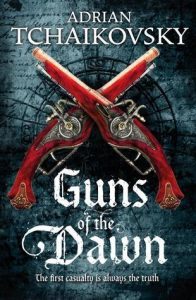 Emily Marshwic, noblewoman, lady of leisure, who’s never done a day of work in her life, is now sweat-soaked and knee-deep in a marsh with the musket-carrying footsloggers, trying to hold off the republican Denlanders and protect her king and country from this new world revolution.
Emily Marshwic, noblewoman, lady of leisure, who’s never done a day of work in her life, is now sweat-soaked and knee-deep in a marsh with the musket-carrying footsloggers, trying to hold off the republican Denlanders and protect her king and country from this new world revolution.
It begins as all wars do. Young men sign up for adventure. Some die. The enemy is demonised and more men sign up to kill them. Then the casualties start piling in. And the years pass. And less people sign up until there aren’t enough and the draft begins. And that’s where our Emily steps into a uniform.
In the opening of the book, Tchaikovsky expertly creates a feeling of the home from during the war when it was fresh, ageing, and stale in what felt like just a few short pages. He is an expert in setting the scene and the context; at times it felt so aligned to the history books I’ve devoured over the years that it could almost be real.
Tchaikovsky’s depiction of the changing psyche of soldiers, or their gradual detachment from their old lives and who they were and what they cared about is utterly enthralling. He depict the mentality of soldiers pre-war, during war, and post-war. It feels like he’s really done his research on PTSD, returning home soldiers, and men and women at war. Emily’s feelings and views and descriptions really hit the mark.
Guns of the Dawn feels like a mixture of The Patriot, Kokoda, Band of Brothers, and All Quiet on the Western front all wrapped into one flintlock fantasy story. All told, Guns of the Dawn is a magnificent read. It’s highly engaging, action packed, and hits all the right emotions throughout to keep you turning the pages.
Read Guns of the Dawn by Adrian Tchaikovsky
The post REVIEW: Guns of the Dawn by Adrian Tchaikovsky appeared first on Grimdark Magazine.
REVIEW: Pawn’s Gambit by Rob J. Hayes
Pawn’s Gambit by Rob J. Hayes is one of my most anticipated releases for 2021, and it lived up to the hype. Last year I had the pleasure of reviewing the Wuxia epic Never Die, it was my first introduction to Rob as a writer, and I got to say that his books are fast becoming some of my favorites.
“Beauty is emotion, good or ill. Pain or happiness or fear or love. Beauty is in the experience.”
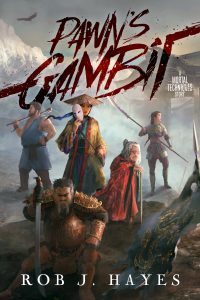 From my review, “Never Die is centered around Ein…and has been sent on a quest from God. ..For Ein’s mission to succeed, the mysterious and powerful Emperor of Ten Kings must fall. To succeed in his quest, Ein must walk barefoot across the cities, mountains, and rivers of the countryside and never don footwear. Ein must select champions to fight the Emporer for him, and these champions must die first so that their souls are tethered to Ein.” Never Die was the first installment in the Mortal Techniques world. Pawn’s Gambit takes place many years after Never Die and is not a sequel, although there is some fun scattered Easter eggs for the readers of Never Die to enjoy.
From my review, “Never Die is centered around Ein…and has been sent on a quest from God. ..For Ein’s mission to succeed, the mysterious and powerful Emperor of Ten Kings must fall. To succeed in his quest, Ein must walk barefoot across the cities, mountains, and rivers of the countryside and never don footwear. Ein must select champions to fight the Emporer for him, and these champions must die first so that their souls are tethered to Ein.” Never Die was the first installment in the Mortal Techniques world. Pawn’s Gambit takes place many years after Never Die and is not a sequel, although there is some fun scattered Easter eggs for the readers of Never Die to enjoy.
Instead, Pawn’s Gambit is a stylized Wuxia epic with some steampunk and game theory thrown in that takes place in the same world of Never Die. It has the same rules and techniques, which we learn more about, but it is about redemption and finding peace.
“Yuu shrugged. “Throw her a tea party or something, sure. Whatever works.”
Pawn’s Gambit’s plot centers around the protagonist Yuu, also known as The Art of War. Yuu is a former famous military strategist, who wears a white mask at all times, and is known for pulling out military wins in the direst of situations. Her ability to see all the angles of a fight are legendary. Though these wins often come at the high costs of human lives lost. Her grandmother, the previous incarnation of Art of War, trained Yuu in all the aspects of war and strategy. However, unlike Yuu’s grandmother, Yuu cannot separate herself from the battles. She feels the pain of the deaths that she helped cause, even if she won the war. They weigh heavy on her heart.
“Failure was always due to a lack of focus. With enough attention and preparation, no outcome could not be predicted, and no situation could not be overcome.”
Five years ago, Yuu made a choice that cost her the thing she held most dear but won the battle. The repercussions of that choice caused her to drop the mask and leave batteling forever. She no longer wanted to be The Art of War. Now five years later, we find Yuu sitting in a bar, getting drunk as she does every night, fleecing men for coin in battles of chess. It is below someone who was once The Art Of War, but at this point, all she wants to do is forget and drink till she feels the pain of the loss no more.
Meanwhile, in another realm, the Gods are having a battle of their own. Every 100 years, the gods have a contest to see who will sit upon the throne for the next 100 years. The God who is currently sitting on the throne, Batu, is the God of War. He has brought nothing but devastation and horror to the land of men for the last 100 years. He cannot help it; it is his nature. But it is time for a change.
“The first step toward winning is knowing which game you are playing.”
The contest is this: Each God participating must give up a thing they hold most dear. The objects are placed throughout the land, and champions, chosen by the benefactor God, must go out and find those objects. Whoever has the most items wins. It is a grand scavenger hunt. Natsuko, the Goddess of missed opportunities, has chosen her champion, Yuu. Yuu is not thrilled with this. 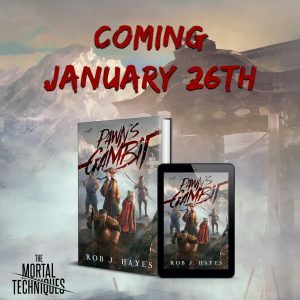
Yuu is an interesting character. She is one of those types of characters that isn’t likable, but she could care less about being liked. She has a core of inner strength that you can see even when readers start the story, and we see Yuu at her very lowest point. But this story is her redemption arc, and what that redemption actually is, is up to the reader. Hayes doesn’t concretely define what redemption looks like for Yuu. I think that makes her a stronger and more interesting character. She has layers and different parts to her. Is she the strategist, the friend, the woman, the human? I am not sure, but I know that the various facets of Yuu are tested thoroughly throughout this story.
The dialog for the story is funny and very human. Hayes can bring out a situation’s nuance and doesn’t need to pound the reader with heavy-handed dialogue. This made me relate all the more to Yuu and the supporting characters she finds along the way to help her. These characters, seen on the superb Felix Ortiz and Shawn T. King cover, help her in different ways. The journey is not the same as Never Die, but there are similar teamwork elements that carry through.
Pawn’s Gambit is a worthy addition to the Mortal Techniques series and a follow-up to Never Die. It is pure adventure and heart. It is really good, and I am so excited that I got to immerse myself in this Wuxia inspired world with great characters, exciting fight scenes, and heartfelt dialog once again. This story asks some big questions and challenges what redemption is.
You should come and take this journey with Yuu; you will not regret it.
Read Pawn’s Gambit by Rob J. Hayes
Please check out some of the other reviews on the tour
The post REVIEW: Pawn’s Gambit by Rob J. Hayes appeared first on Grimdark Magazine.
January 20, 2021
REVIEW: The Expanse Season Five Episode 8 – Hard Vacuum
It’s Wednesday and you know what that means–more Expanse and we’re up to episode eight, titled Hard Vacuum, and given we last saw Naomi Nagata about to expire in an airlock after making a dramatic leap through the void, that’s what I call foreboding. As always, if you aren’t up to where we are, switch the afterburners on and scoot. Spoilers follow.
 Of course, we start instead with Amos and Clarissa Mao who are making their way across a rapidly devolving countryside in the wake of the asteroid impacts on Earth. Clarissa is now mostly recovered from the anti-mod blockers and her exertions in making mince out of the prepper whose house they occupied a few days back. The pair find a load of elderly folk in body bags. Amos assumes the building was an old folks home and they were killed when they couldn’t care for themselves. Clarissa says she hopes it was done humanely and asks if it’s always going to be like this. Amos says it will be at least for a while. Clarissa says she knows where they can get a ship, but they’ll need help.
Of course, we start instead with Amos and Clarissa Mao who are making their way across a rapidly devolving countryside in the wake of the asteroid impacts on Earth. Clarissa is now mostly recovered from the anti-mod blockers and her exertions in making mince out of the prepper whose house they occupied a few days back. The pair find a load of elderly folk in body bags. Amos assumes the building was an old folks home and they were killed when they couldn’t care for themselves. Clarissa says she hopes it was done humanely and asks if it’s always going to be like this. Amos says it will be at least for a while. Clarissa says she knows where they can get a ship, but they’ll need help.
Onboard the Free Navy, Marco is eulogizing Cyn in quite touching terms. He asks Filip how Naomi died. Filip tells him that she wanted to die and Cyn tried to stop her, but she didn’t have to kill him. Marco cuts him off and blames Filip for his death.
Naomi wakes up on board her ship, the Chetzemoka, and is clearly suffering from the effects of her leap through the void. She finds the control screens are broken and the whole ship wired up as a bomb.
She hears talking rattling through the ship and finds a simulated recording of her voice calling out to the Rocinante for help.
On board Drummer’s little fleet, things are pretty awkward as they salvage from Belter ships that fell foul of the Free Navy. Meanwhile, Karal is listening in, very much there as Inaros’ agent.
David Pastor makes his first address as the new secretary-general. He gives Avasarala and Delgado their credit for stopping the attack and announces a manhunt for Inaros in stirring terms, and we find out afterwards that Crisjen coached him on this.
Amos and Clarissa get into Baltimore and try to get help from his old friend Eric who initially dresses Amos (well, Timothy) for coming back. They offer a way off the planet but Eric doesn’t want to leave after all he’s built up here. He gets talked around by Clarissa and speaks about how he watched the aftermath of the impact and the sea just swept so much of the familiar city away.
There is a security council meeting on Earth and Delgado says they need to make a strike, suggesting Pallas station be attacked. Crisjen argues against that as it’s attacking a civilian target, saying this will set all Belters against them, even those who don’t already support Inaros.
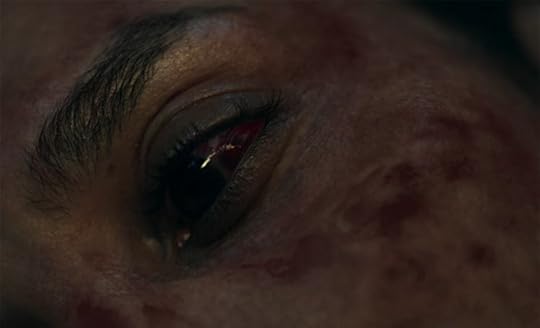
Image Credit: Amazon Studios.
Naomi is desperately trying to stop the message baiting the Rocinante from broadcasting, despite being injured. She attempts to wire up the comms in a busted up spacesuit to send out a new message that the ship is a bomb and she has no control.
Things are still super tense on Drummer’s ship as some of the crew worry about working with Inaros and others see regret as looking back. The tension is alleviated for a moment by some antics with water floating in microgravity, but it soon returns.
Alex and Bobbie on the Razorback pick up a message from Naomi and transmit it to on the Rocinante. It’s the bait message luring them into a trap.
Delgado and Pastor again debate the morals of an attack on a civilian Belter installation.
Naomi gets a message from Alex on the Razorback, saying they’ll get to her soon.
She realises that her attempt to send out a different message has failed and realises she needs to go out into the Hard Vacuum of the rest of the ship to somehow alter the message as it goes out.
Drummer hears the original bait message and is set to go and save Naomi but Karal tells her Naomi is dead and it’s a trap. Drummer hits the bottle hard.
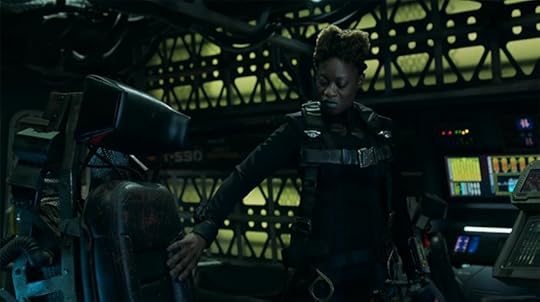
Image Credit: Amazon Studios.
Naomi makes over ten trips out into the ship, breathing out into her makeshift suit and risking asphyxiation each time, reciting the message in her head as she tries to blank out portions of the broadcast. Finally, she manages to change the message to say she’s in control.
On Drummer’s ship, Karal realises that the message has been changed. Oksana is also there and wonders if Naomi could be alive and have changed it and on that note, the episode ends.
Thoughts on Hard VacuumI have to admit that I was expecting a more explosive episode this week but Hard Vacuum played on the emotional weight of the previous episode to give us a tense portrayal of Naomi’s tenacity and determination to somehow save her chosen family from death at Marco’s hands, trying to save her.
Ultimately, Hard Vacuum is all about Naomi and everything else takes a backseat to a standout performance from Dominique Tipper. Even more impressive is that this week it’s not her poise, delivery, and code-switching that stands out as would usually be the case but her physical portrayal of desperation and pain and sheer bloody-mindedness.
So much of this season has been about building tension and emotional momentum and I can’t be annoyed at that being cranked up even further as we get to the final two episodes of the season, even if I’d been hoping for some more immediate thrills in this episode.
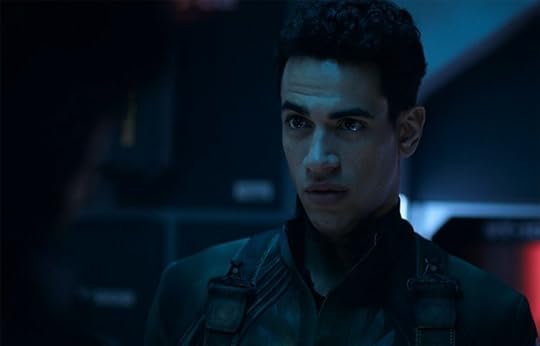
Image Credit: Amazon Studios.
At this stage we’ve got Naomi on a near-derelict ship, defying death while almost killing herself to save the friends who are now fast approaching with rescue in mind. We’ve got the tense atmosphere between Filip and Marco and also on Drummer’s pirate ship and lastly, we’ve got Amos, Clarissa, and Eric about to take some risks to take the ship off of Earth.
The stakes couldn’t be higher or more personal, the setting continues to get grimmer, and the likelihood of positive outcomes slimmer by the second. You love to see it.
What did you enjoy in Hard Vacuum and what are you looking forward to as the story continues?
Episodes 1-8 of Season Five and all prior seasons of The Expanse can be streamed via Amazon Prime – and new episodes are coming every Wednesday.
The post REVIEW: The Expanse Season Five Episode 8 – Hard Vacuum appeared first on Grimdark Magazine.
REVIEW: Vampire: The Masquerade – Winter’s Teeth #4
Vampire: The Masquerade – Winter’s Teeth #4 is the penultimate issue of the mini-series that, hopefully, will end up being turned into an ongoing. Tim Seely’s work is an homage to the Nineties Goth and punk scenes combined with the tabletop game that was inspired by them. I’ve really enjoyed its political and character-driven take on what being a vampire in the Twin Cities might be like. The fact Cecily Baine is a former rocker girl that grew up in the heyday of the Goth club scene.
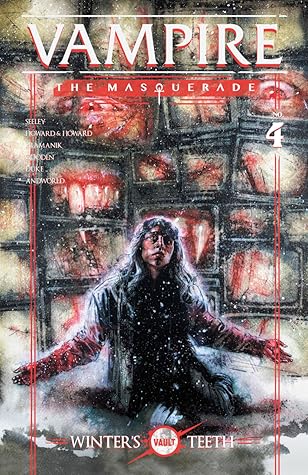 The premise of this comic is that in the Twin Cities, vampires exist and are possessed of a complicated society of the undead that includes both the Haves (Camarilla) and Have Nots (Anarchs). Cecily Bain is a former Anarch who has become Camarilla stooge in order to try to make her life easier (due to her mortal sister becoming disabled and needing constant care). She’s since adopted a young vampire named Alejandra and is investigating a series of murders among the undead.
The premise of this comic is that in the Twin Cities, vampires exist and are possessed of a complicated society of the undead that includes both the Haves (Camarilla) and Have Nots (Anarchs). Cecily Bain is a former Anarch who has become Camarilla stooge in order to try to make her life easier (due to her mortal sister becoming disabled and needing constant care). She’s since adopted a young vampire named Alejandra and is investigating a series of murders among the undead.
The death of the Prince in the previous issue has thrown the Twin Cities in chaos and Cecily is torn between believing it the work of renegade hunters versus a plot within the undead’s society. It doesn’t help that she’s saddled with a vampire childe that doesn’t have any idea about what sort of dangers they may be facing (though even that may be a lie).
The best part of Vampire: The Masquerade – Winter’s Teeth #4 is that it gives a good insight into not only how Cecily behaves but also how she sees herself. She thinks of herself as a moderate and even empathetic person who has been driven to her harsh stance in order to survive. Everyone else who meets her sees only the dark and angry side of her Brujah personality. Cecily resents the idea she could not be a kindergarten teacher, as ridiculous as that sounds.
We also get an insight into the functioning of vampire politics and society. Much like the mob, all of them are playing an angle against one another and there is absolutely no one that can be trusted. At one point, Cecily falls under attack by some of her old allies among the Anarchs. Cecily seems genuinely surprised at their betrayal despite the fact she’d been working for the Camarilla for years at this point.
If I had any complaint about the book, I would have to say that the previous one felt a little unnecessary in retrospect. This is much more about the politics and scheming of the undead. If we’d used the previous book to establish these characters more then I believe the subsequent gamesmanship would be stronger. These games depend on a stable cast of good guys, bad guys, and worse guys to really make the social combat element shine.
The art of these comics is beautiful and much more naturalistic than most comics. The characters aren’t all incredibly beautiful Olympians but include a wide variety of body types as well as races. I also appreciate the tabletop game write-ups in the back of the book that are a great bonus for the gamers reading this.
Read The Masquerade – Winter’s Teeth #4
The post REVIEW: Vampire: The Masquerade – Winter’s Teeth #4 appeared first on Grimdark Magazine.
January 19, 2021
REVIEW: The Mandalorian Season 2
Yes, it’s Star Wars and yes, it’s Disney, but The Mandalorian Season 2 veers closer to the grimdark underbelly that *must* exist beneath the Star Wars universe more than anything since the heyday of the old Expanded Universe.
Helmed by Jon Favreau and George Lucas, with an impressive budget and all-star cast, the first series set the stage as more of a western that happens to be in space than the flamboyant space opera of the main Star Wars series. This was a good decision, playing off the successes of Star Wars Rebels and that’s an influence that would be even more prevalent in the second series.
Beloved tropes like a taciturn outsider who is humanised by an attachment to a cute sidekick might seem pat, but they’re cliche because they work.
The Mandalorian Season 2 sees Mando/the Mandalorian (Pedro Pascal) seeking out the mysterious Jedi to help find the Child (that’s Baby Yoda) someone who could both protect him and develop his Force powers. They are still pursued by Moff Gideon (Giancarlo Esposito) and their attempts to keep ahead of him are not exactly successful.
Along the way, they get help from familiar figures like Cara Dune (Gina Carano) and Greef Karga (Carl Weathers) and Fennec Shand (Ming-Na Wen) while bumping into legendary figures like Boba Fett (Temura Morrison) and a group of other Mandalorians, let by Bo-Katan Kryze (Katee Sackhoff.)
There are a lot of high profile actors making guest appearances, including Timothy Olyphant, Michael Biehn, and John Leguizamo, but Rosario Dawson’s turn as much-storied Jedi, Ahsoka Tano (best known from Star Wars Rebels and the Clone Wars cartoons) stands out.
The setting of The Mandalorian Season 2 places it on the Outer Rim of the galaxy and in a time of great change as the New Republic tries to exert its authority while the Imperial Remnant tries to hang on. This frontier which is as much fought over by criminal cartels and folks trying to get by as it is by the Republic or Imperials leads to a lot more shades of grey in the storytelling and gives a glimpse into the inner workings of a universe we’re all too used to seeing from the top down and through the lens of one particular family.

In a lot of ways The Mandalorian Season 2 owes more to Firefly or Kung Fu than the Empire Strikes Back or the Rise of Skywalker and in my eyes that’s unquestionably a good thing.
The Mandalorian Season 2 is beautifully shot, well-acted and relies on simple storytelling to craft both fun monster-of-the-week episodes and a compelling series-long arc. Most importantly, we come to care about the main characters–which is impressive when one of them wears a mask and the other is animatronic.
It’s not really grimdark, but it is arguably the best live-action Star Wars we’ve had since the 1980s and one of the most fun, if not exactly challenging science-fiction series available to stream at the moment.
4/5
The Mandalorian Season 2 (and Season 1) can be streamed, along with almost the whole Star Wars canon on https://www.disneyplus.com
The post REVIEW: The Mandalorian Season 2 appeared first on Grimdark Magazine.




